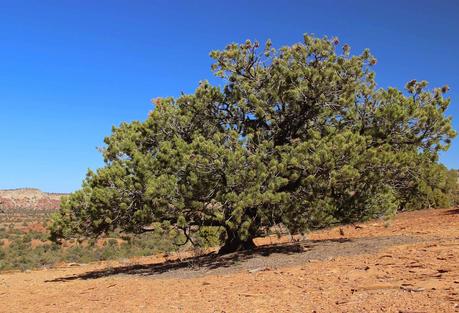
Tree is about six feet tall; crown is twelve feet across and loaded with cones.
The small pine I dreamt about last night must have been a pinyon. The site looked right: dry, rocky, sparsely-forested – really more of a woodland – and little ground cover. Yes, it must have been a pinyon pine.Do I repeat myself? No, pinyon pine is not a tautology – not one of those pointless combinations of English and Spanish like Table Mesa (tr: Table Table) or Cuesta Grade (tr: Grade Grade). A pinyon (piñón in Spanish) is the seed (often called a nut) of the pinyon pine (pino piñonero in Spanish). We call the trees pinyons for short.
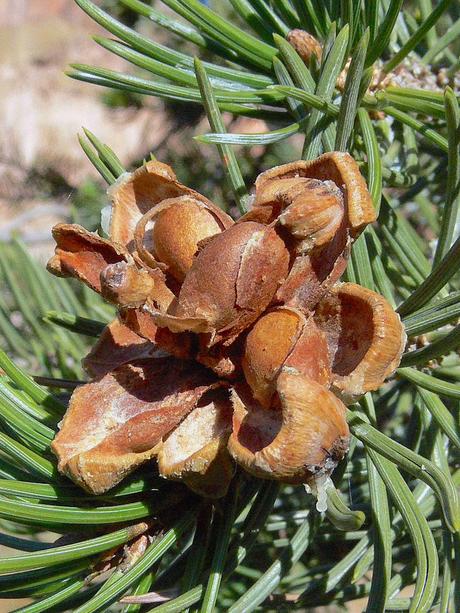
Small trees, small cones, BIG seeds! Source.
The seeds of pinyon pines are large and nutritious – so much so that jays, humans and other animals put a lot of time and energy into collecting them. Pinyon jays are especially dependent on pinyons. In late summer, they go to work picking sticky sappy green cones and hammering them apart to extract fat seeds. These they carry to traditional nesting areas, where they stash them on the ground among dead needles and twigs. The jays continue collecting into fall; their work gets easier as the cones dry and open up.By the time the harvest is over, many thousands of pinyons have been cached. When spring comes, they're eaten by nesting female jays and the young fledglings. But some seeds are always overlooked, and some germinate and grow. Thus the jays return the favor … by planting pinyon pines.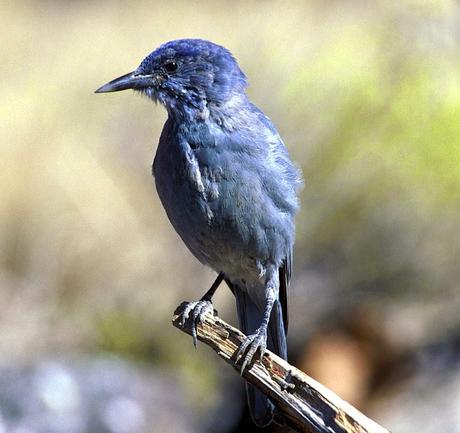
Pinyon jay. In the old days, Westerners called it the blue crow. Source.
There was a time when people also survived on pinyons. In the old days, tribes harvested and stored seeds each fall. Tasty, nutritious, calorie-rich pine nuts made excellent winter food, especially where agriculture wasn’t possible. But in some years, pinyon yields were poor; for tribes without agriculture, such years were very tough.Pinyon pines are rare here in Wyoming. This is the north edge of their range; they grow only in the extreme southwest part of the state. When I visited Flaming Gorge Reservoir last fall, I found a few close to the state line (with Utah). They were mostly saplings and young trees. Does this mean the pinyon is extending its range?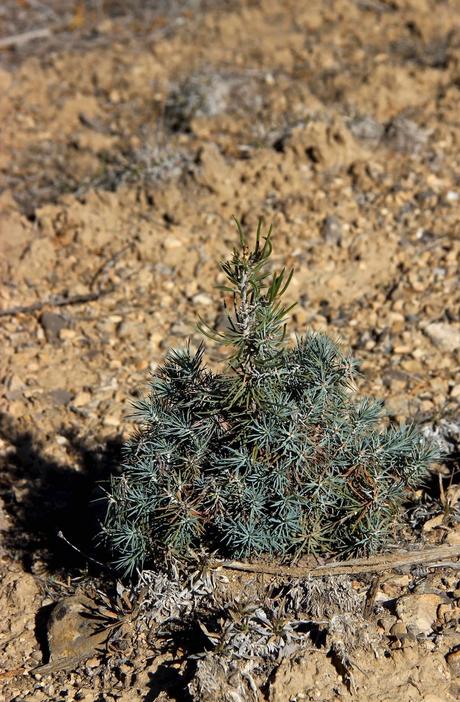
Pinyon youngster.
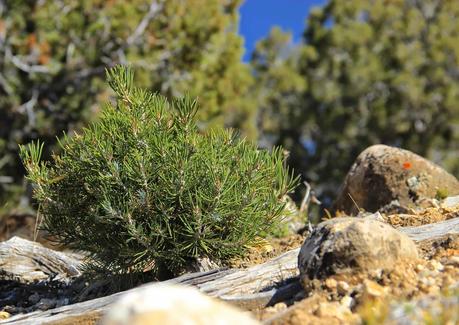
Small but vigorous sapling.
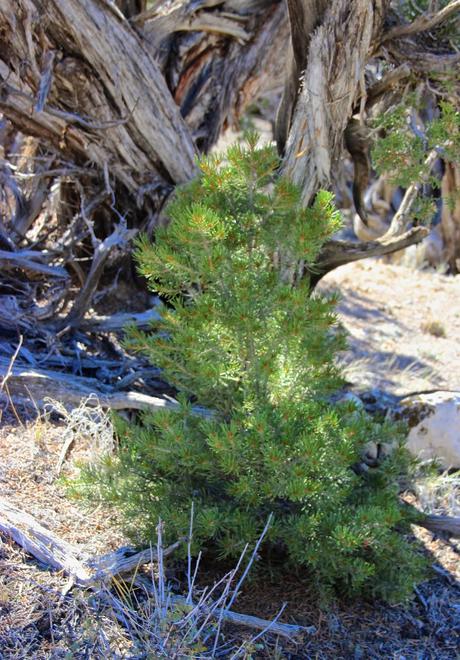
Pinyon sapling in shady habitat. The two-needle pinyon, Pinus edulis, is the one that grows in Wyoming.
Soon I will be where pinyon pines are common – where they partner with junipers to form pinyon-juniper woodlands that occupy more than 75,000 square miles in the western US. On the Colorado Plateau, the pinyon is the two-needle, Pinus edulis, the source of "American" pine nuts. As the name suggests, they have two needles per fascicle (bundle) ... usually. Some individuals also have three-needled fascicles.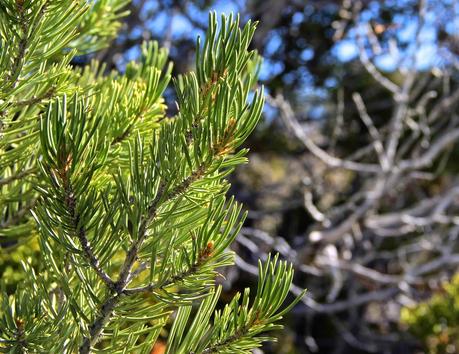
Two-needle pinyon pine, also called Colorado pinyon pine.
When I leave the Colorado Plateau and enter the Great Basin to the west, the pinyons will change. Single-leaf pinyon, Pinus monophylla, will replace the two-needle. As you might guess, it has a single needle per fascicle.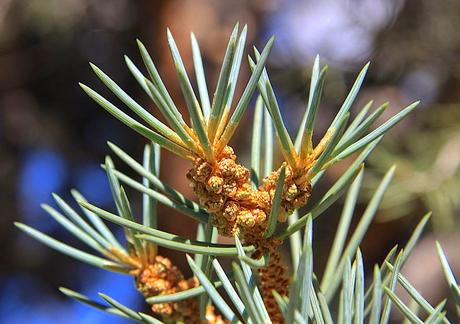
Single-leaf pinyon. Needles are single but still “bundled” – note fascicle along base of each. Source.
I expect to see the single-leaf pinyon off-and-on for much of the trip, as it also grows in the Mojave Desert, Tehachapi Mountains and as far west as the southern Coast Ranges of California. This was the first pinyon pine I met ... long ago. I made its acquaintance in the Coast Ranges when I was a field botany student. I look forward to renewing our friendship.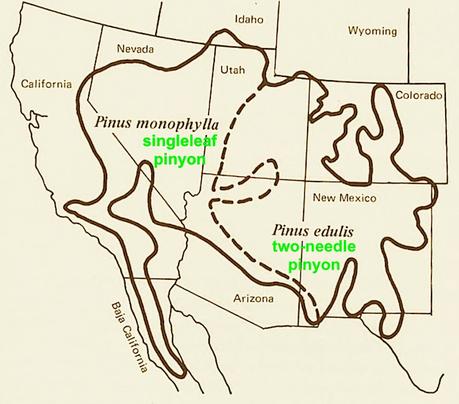
Where the pinyon pines grow. After Lanner 1981.
I'm eager to find, photograph and learn more about pinyon pines. Already they impress me, in part because they defy our concept of great trees. We generally admire trees for being tall, strong and ancient. We have organizations devoted to finding and registering the largest individual of the various kinds of trees – the champions. But is anyone looking for a champion pinyon pine? Probably not.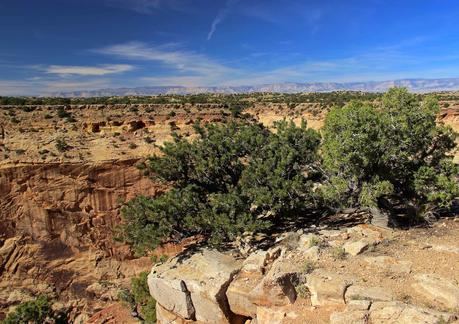
Two-needle pinyon with its woodland partner, the Utah juniper. All three of us are 5 ft 6 in tall.
In harsh arid habitat, the pinyon pine’s small stature makes it a survivor. It's tough, tenacious, and photogenic. But it wasn’t always this way. Pinyons used to be as tall as other trees. This is what happened:In the old days the Washo people lived by a river created by Wolf-god. Every fall they gathered to collect pine nuts – and hunt, feast and sing. But then there was a terrible drought and the river dried up. Fires destroyed the pines, so there was no food. Many people died; the rest were severely weakened. Wolf-god came back to help. He scattered pine nuts, and trees soon grew. But the people were too weak to climb. Wolf-god tore off the tops of the trees, and put them directly in the ground. The Washo could harvest nuts from the low crowns, so they survived.

Pinyons would be unaffordable if Wolf-god hadn’t made the cones easy to reach. Source.
Sources (in addition to links in post)Lanner, RM. 1981. The piñon pine, a natural and cultural history. University of Nevada Press, Reno.
